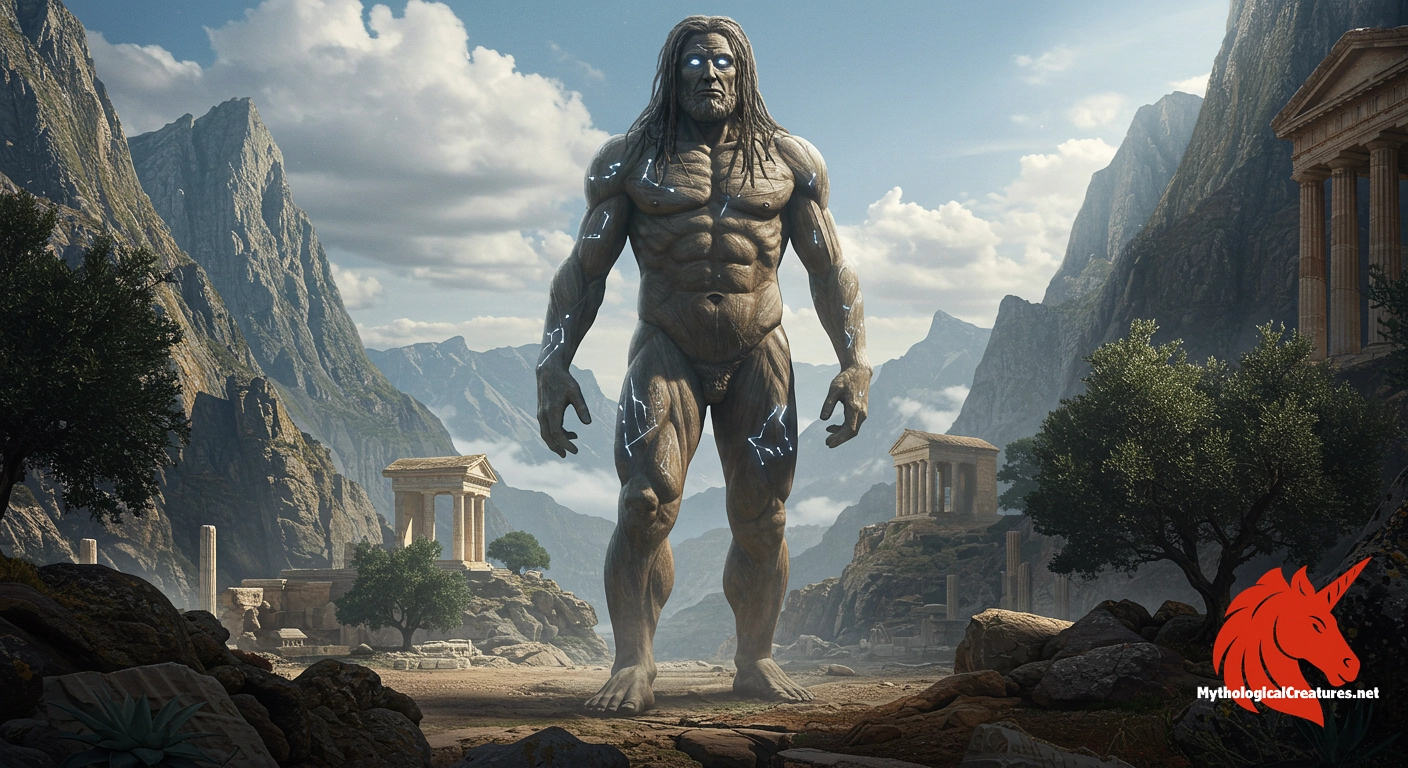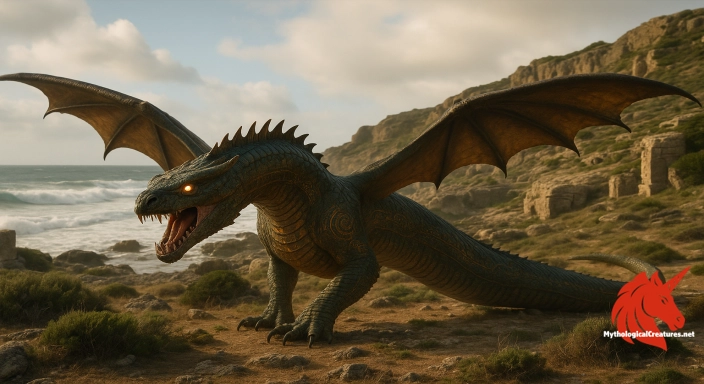Crius: Crius is a male Titan from Greek mythology, known as one of the primordial children of Uranus and Gaia.

Crius
Crius - Crius is one of the primordial Titans, significant as a foundational figure in the Greek cosmogony.
Origins & First Encounters
Crius emerges from ancient Greek narratives as one of the primordial Titans whose origins can be traced directly to the union of Uranus and Gaia. His very existence represents the nascent cosmic order that later gave way to the supremacy of the Olympians. Born at the dawn of time, Crius is part of a family that personified the natural forces and complexities of the universe, even though his myth is less elaborated than that of his siblings. He is chiefly mentioned in early genealogical accounts, where his role, though understated, reinforces the structure of divine ancestry. His presence in Hesiod’s Theogony signals the archetypal nature of these elder deities, whose influence helped shape the ancient Greek understanding of the cosmos. The sparse records suggest that Crius may have symbolised aspects of the heavenly order, hinting at a connection with the vastness of the skies. Several interpretations of his myth subtly associate him with the measure or direction of the constellations, thus linking him to celestial imagery. Over time, even brief allusions to his name have served to underscore the mystery and grandeur of the early mythic world. Ancient poets and philosophers retained his memory as a marker of the primal era, when chaos and order coexisted in delicate balance. In the broader tapestry of Greek mythology, Crius maintains an enigmatic role that invites ongoing curiosity and contemplation.
Source Texts & Tale Variants
Ancient texts such as Hesiod’s Theogony are the primary sources that mention Crius, positioning him among the Titans of old. Although his narrative contributions are minimal compared to more celebrated Titans, these early works assured him a place in the structured genealogy of the gods. In addition to Hesiod’s account, fragments found in later mythographical compilations consistently reference his lineage without elaborating on distinct myths. Some later sources, like the accounts of Apollodorus and other classical compilers, include him in lists that underscore the legacy of Uranus and Gaia’s progeny. These scant literary references have driven modern scholars to piece together his character from brief mentions and genealogical charts. Variations in the texts have led to alternate interpretations of his significance in the Titanomachy, even if no detailed legend describes his deeds. Poetic and philosophical works from different periods occasionally invoke his name as a symbol of the ancient cosmic structure. The preservation of his identity in these sources highlights the ancient Greek focus on order and hierarchy in the mythic cosmos. Subsequent retellings by later classical and Byzantine authors have echoed these sparse details, leaving room for interpretive expansion. Despite the limited narrative, the traditional sources collectively contribute a framework for understanding his presence in myth.
Form & Powers
Visual interpretations of Crius suggest an imposing figure shrouded in the mystery of antiquity, even though original depictions are rare. Artists and later mythographers have imagined him as a robust, towering presence with a physique crafted to evoke the raw power of nature. His form is often conceived with broad, muscular shoulders and a stature that symbolises the primordial forces he embodies. In many reconstructions, Crius is depicted with a weathered visage, accented by a flowing, wild mane that speaks to the untamed origins of his kind. The detailed elements of his facial features, such as deep-set, reflective eyes and a pronounced, stern expression, aim to capture the gravity of ancient times. Some visual portrayals hint at an almost celestial quality, with subtle references to the constellations and the expanse of the night sky. Although the exact size and proportions vary, his depiction consistently aligns with the archetypal Titan, exuding an enduring sense of authority and enigma. Elements like a well-tended beard and rugged, earth-toned skin further enhance the image of a deity who has witnessed the unfolding of the cosmos. The blend of naturalistic and symbolic traits in his portrayals underscores the melding of myth and art in ancient Greek culture. Modern artistic interpretations continue to draw inspiration from these elements, reimagining him as an emblem of primeval cosmic power.
Regional Faces
The figure of Crius has travelled through various regional adaptations, even if his core identity remains rooted in Greek mythology. In the Aegean and parts of Asia Minor, local traditions lightly reinterpreted Titan lore, occasionally ascribing additional celestial duties to him. These regional variants subtly emphasise his association with the horizon and the orderly movement of the stars. While the primary narratives remain consistent with the canonical genealogies, local rites sometimes hinted at his role as a guardian of ancient cosmic rhythms. In some Hellenistic circles, he was seen as an elemental force that helped structure the natural world, a role that resonated with the local fascination for astronomy and divine order. Roman adaptations of Greek mythology occasionally incorporated elements of Titan mythology into their own narratives, thereby casting figures like Crius in a slightly modified light. During the Byzantine era, retellings of myth occasionally attributed him with abstract qualities connected to fate and the inexorable flow of time. Regional cult practices, though minimal and fragmented in evidence, reveal that ancient communities occasionally revered even the lesser-known Titans as representations of primordial power. These localized interpretations contributed to a rich tapestry of myth that allowed Crius to maintain an enduring, if subtle, presence across cultures. Such adaptations underscore the fluidity of myth and the capacity of regional traditions to mould even the most arcane figures into locally revered symbols.
Cultural Parallels
Crius occupies an interesting position when viewed alongside similar mythological archetypes across diverse cultural landscapes. While his role in Greek mythology is that of a primordial Titan associated with the cosmos, figures in other traditions, such as the Norse Ymir, also embody the raw elements of creation and the chaotic origins of the world. His elusive narrative and embodiment of elemental order resonate with deities who symbolise the vast, often unfathomable, natural forces in other cultural mythologies. Comparisons with figures like Uranus highlight a recurring theme in ancient myth: the transition from chaotic beginnings to the structured order of later divine hierarchies. In certain Eastern myth traditions, a similar emphasis on the cosmic order is echoed by ancestral figures who dictate the movement and balance of nature. This cross-cultural pattern reflects a widespread human endeavour to explain the cosmos through the actions of supernatural entities. The shared motifs—such as the embodiment of celestial order and the bridging of terrestrial and divine realms—connect Crius to a broader narrative found in many mythic systems. While the particulars differ, the overarching conceptual role of translating the chaos into order is a common thread that runs through ancient stories worldwide. Modern comparative mythology often uses such parallels to highlight universal themes in humanity’s mythological imagination. This interplay of narrative elements encourages a dynamic dialogue between different cultural mythologies, deepening our appreciation of ancient cosmic symbolism.
Legacy & Modern Evolution
Over the centuries, Crius has transitioned from a relatively obscure Titan into a symbol reinterpreted to embody the enduring mysteries of the cosmos. Early classical sources treated him merely as a genealogical marker, yet his part in these ancient tales provided a foundation upon which later thinkers could build more elaborate cosmic narratives. In the Renaissance, a renewed interest in classical mythology led artists and philosophers to re-examine the Titans, with Crius often emerging as a subtle emblem of time's relentless march. His austerity and ancient gravitas have made him a subject of scholarly intrigue, inviting reinterpretation in the light of modern cosmological ideas. Contemporary literature and art sometimes evoke his name to suggest an elemental connection to the heavens and to the primordial order. His evolution in modern retellings reflects both an admiration for classical tradition and an innovative spirit that seeks to redraw the boundaries between myth and science. While he remains less prominent than other Titans in popular culture, his symbolic presence endures as an inspiration for creative expressions of ancient cosmic power. Modern adaptations harness his enigmatic identity to explore themes of destiny, the cyclical nature of time, and the interplay between chaos and order. His legendary, albeit understated, existence continues to encourage both academic and artistic exploration, reinforcing his status as a timeless emblem of the ancient world. Crius, therefore, stands as a reminder that even the most elusive mythic figures can embody vast, universal truths that resonate through the ages.
Interesting Fact
Though not as widely celebrated as other Titans, Crius' role as an ancestor to many divine beings underscores the intricate familial ties in Greek mythology.
Quick Creature Info
Origin:
Our Mythic Legendary Rating:

Also Sometimes Known As:
Supernatural Powers:
Physical Attributes:
Abilities:
Lore:
References
Discover Another Mythical Legend You May Not Have Heard Of?
Uncover the mysteries of ancient folklore and expand your knowledge of legendary beings from cultures around the world.
Dare to Meet the Azhdaha....
Mythical Disclaimer: The images and data on this site are derived from various historical and literary sources, but we have found that many myths often have multiple versions and interpretations across references, sometimes contradictory. As a result, these creature depictions are artistic interpretations—imaginative blends of folklore, legend, and a dash of AI guesswork. Because creature descriptions vary widely, our illustrations and accompanying information represent our best effort to honor mythology while bridging creative gaps. Enjoy these interpretations—just remember, we've done our best to respect the stories and validate available data, but in the realm of mythology, details often shift, imagination leads the way, and nothing is ever set in stone!
Curated by the Mythological Creatures Team (rev. May 2025)
